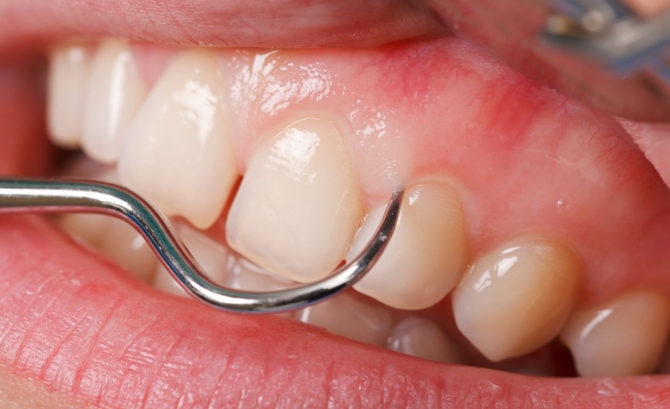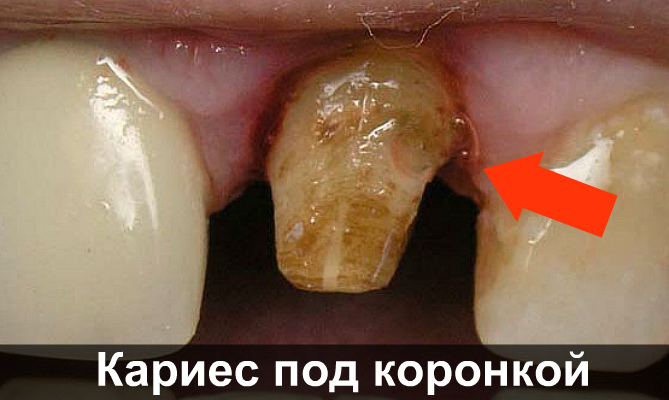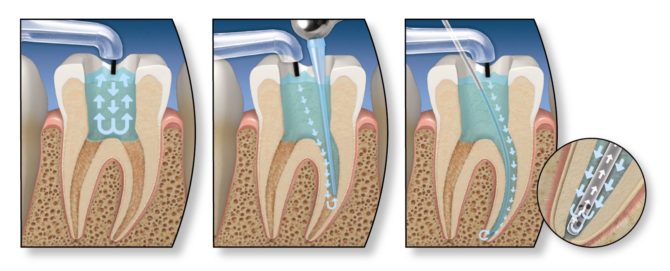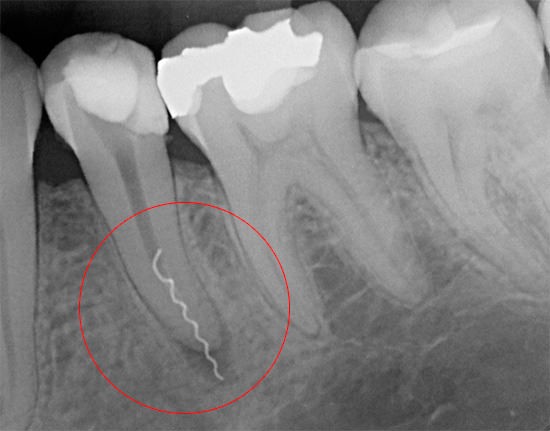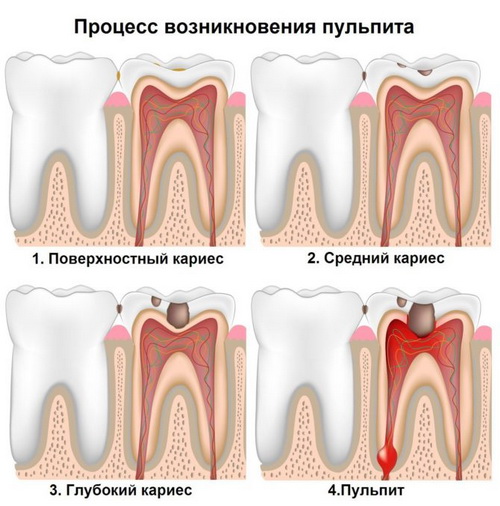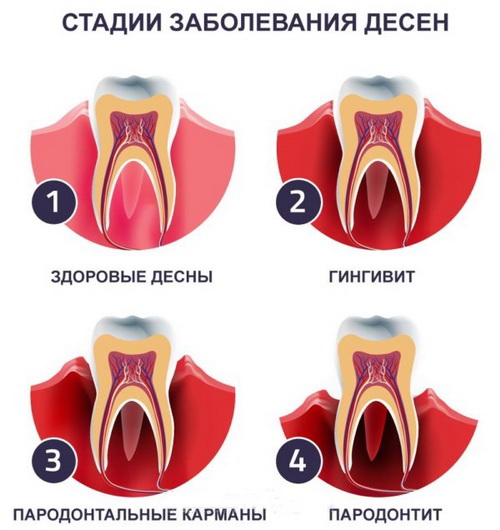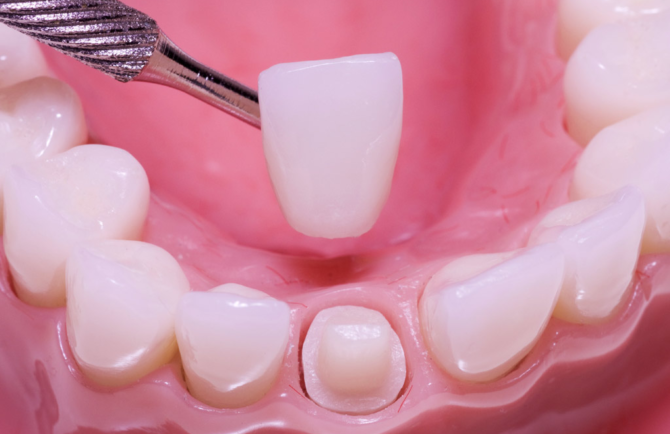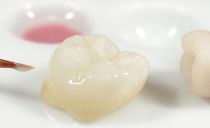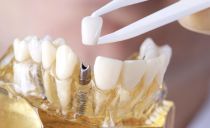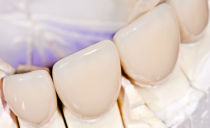Why does the tooth hurt under the crown and what to do about it
Any toothache makes a person go to the doctor. But the situation when the tooth aches under the crown is alarming in a special way. Behind the painful procedures for preparing for prosthetics, a lot of money, time and nerves were spent. It would seem that with an updated tooth everything should be perfect: it is treated and protected from all sides. But the pain does not subside, and even becomes stronger.
If the tooth hurts under the crown, you can relieve pain at home, but you can’t do this often. As soon as free time appears, you need to visit the dentist so that he eliminates the cause of the phenomenon before complications develop.
Content
How to relieve tooth pain under the crown in the first days after prosthetics
The crown, the bridge is also a prosthesis. A foreign element is placed in the jaw, this is preceded by tooth preparation, often quite traumatic. Therefore, if the tooth hurts and achs after installing the crown, or it hurts the person to bite solid food, it’s too early to worry. It is likely that within a few days the discomfort will go away on its own: when the effects of traumatization come to naught, and the gum adapts to the orthopedic design.
The process of getting used to the prosthesis can be facilitated by warm rinsing with a solution of soda (a teaspoon per glass of water), decoctions of sage, chamomile, oregano, calendula, oak bark. To relieve discomfort, the rinse should be kept in the mouth for as long as possible.
What to do if a tooth hurts under the crown for the first time after installation, the orthopedic dentist who puts the prosthesis usually tells the patient in advance. To soothe and restore inflamed tissues, in addition to folk remedies, special ointments and gels are recommended:
- Metrogil dent.
- Solcoseryl.
- Kamistad.
 Usually these funds are enough to stop the gums from becoming inflamed. And if the pain is not only when chewing, but also at rest, so strong that they disrupt the usual course of a person’s life, it is permissible to use painkillers to relieve them:
Usually these funds are enough to stop the gums from becoming inflamed. And if the pain is not only when chewing, but also at rest, so strong that they disrupt the usual course of a person’s life, it is permissible to use painkillers to relieve them:
- Ketanov.
- Ibuprofen.
- Tempalgin.
- Ketorol.
Antihistamines will also bring relief if supplemented with anti-inflammatory drugs. Tavegil, Suprastin, Diazolin, Diphenhydramine, Zirtec and other medicines with anti-allergic effect will quickly remove swelling and inflammation, help the body adapt to new substances for it in the crowns.
The material from which the crowns are made can itself cause an allergic reaction. Usually it is manifested by a rash, redness, and itching in the oral cavity. If such phenomena occur, the crown will have to be replaced.
Why does the tooth hurt for a long time under the crown
If several days have passed since the installation of the crown, and the pain did not subside or even intensified, it does not allow you to put pressure on the tooth, it prevents it from biting - it's time to beware. The problem situation may be different: at first everything went according to plan, and a tooth clothed in a crown did not cause inconvenience, but after some time, maybe even more than one year, it suddenly appeared discomfort, pain when pressed, swelling or flux .
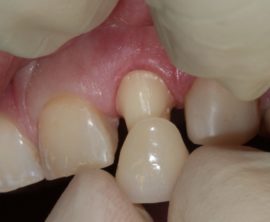 The most common causes of inflammation under the crown:
The most common causes of inflammation under the crown:
- poor preparation of channels;
- low quality filling materials;
- violation of the integrity of the gums;
- errors in fixing the crown;
- destruction of cement;
- crown deformation: cracks, chips, exceeding the permissible life.
The stage of preparation for prosthetics determines the entire future fate of the tooth. The crown can both prolong its existence for many years, and accelerate the destruction, if the focus of infection is hidden under it. Moreover, inflammation can progress for some time asymptomatically, and then result in an acute pain syndrome, which makes it impossible to thoroughly chew food and have a good sleep.
The work of the dentist at this stage can be complicated by the atypical structure of the patient’s canals. Because of their curvature, the microscopic tip of the expander can break and, remaining in the channel under the seal, provoke pain when bitten. But such cases are rare, mainly the outcome of treatment depends on the skill of the doctor, his responsibility in choosing methods, tools and materials, as well as on monitoring the results of work.
Defects of treatment and their consequences
Poor root canal treatment is the most common cause of problems that occur with prosthetics. The risk of inflammation of the root of the tooth under the crown in the future depends on the work experience and the responsible approach of the doctor at this stage. A tool fragment, for example, can remain under the seal not only because of the atypical anatomy of the canal, but also because of the improper rotation mode of the cleaning and expanding devices or their repeated use.
Wrong choice of tool diameter for channel expansion or boron rotation speed can cause a violation of the integrity of the channel wall. The same defect sometimes occurs in preparation for the introduction of the pin or at the time of its introduction. It is important that perforation of the apex of the root is more difficult to notice than a hole in the wall, and subsequently this can lead to severe forms of inflammation, up to periodontitis or the formation of a basal cyst.
Due to incorrect measurement of the channels, an insufficient volume of filling material may be introduced into them, sometimes poor quality material is used, which over time causes a drawdown. For these reasons, voids with foci of infection form in the channels.
It is not good when there is too much filling material in the canal. Due to the part of the filling protruding beyond the apex of the root, the tooth under the crown begins to hurt when pressed.
In order to notice defects of the endodontic process in time, it is necessary to conduct radiological control of all the main stages of preparation of the tooth for prosthetics. At least, the quality of the filling of the channels should definitely be fixed in the picture. Many modern clinics offer cure for dental patients under a microscope. This is an increased guarantee of timely detection of both natural anomalies and dentist defects.
Crown defects
Here we are talking about a violation of both the technology of manufacturing the crown and its installation. The crown is improperly made if:
- Its subgingival part is more than 0.3 mm. This causes permanent tissue injury with swelling and redness, pain and bleeding, especially when pressed, bitten and chewed.
- Its shape does not adequately match the shape of the tooth, which also injures the gum section and can cause secondary caries of the covered tooth.
- If it loosely covers the neck of the tooth, which creates a pocket for the accumulation of pathogenic bacteria, which determines periodontitis, flux and other serious consequences.
In the process of fixing the crown or bridge, the structure could be loose. There is also poor quality cement - then after some time the prosthesis loosens and injures the gums, access to the inside of the tooth opens for caries pathogens.
Poor preparation of the tooth results in the destruction of the marginal tissues of the gums with the subsequent development of the inflammatory process and the likelihood that food particles will fall under the crown. In all these cases, the help of a qualified orthopedist is required.
Small mechanical damage to the crown is eliminated without removing it by conventional filling. With extensive cleavage, cracks, a new specimen is required.
Tooth treatment under the crown
In the vast majority of cases of prosthetics the most sensitive part - the pulp with nerve fibers - is previously removed. A tooth loses its ability to respond to pain, but at the same time, the process of its natural destruction is accelerated. Therefore, whenever possible, they try to preserve the nerve - it is easier to do with chewing teeth that have more than one root.
If a live tooth hurts under the bridge: what to do
A tooth in which a nerve has been preserved usually hurts due to pulpitis, which is formed due to advanced caries. Its beginning could go unnoticed in the process of prosthetics or begin after the protective structure was installed. If caries cannot be cured in the bud, which can be done without removing the crown, it will lead to pulpitis. This disease is the cause of sharp pain at the slightest pressing or biting.
Modern dentistry has equipment with which it is possible to treat a tooth directly under the crown. You can treat the early stages of caries through a small hole, which will then be sealed.
If the disease is started, you will have to remove the prosthesis and thoroughly treat a tooth that suddenly became ill. With a high probability this time the nerve will be removed, and the canals are transected. If caries has spread over a vast surface, after removal of the affected tissue, the shape of the tooth will change, which means that a new crown will be required.
If a dead tooth hurts under the crown
Crowned teeth are susceptible to any disease., only their development at the initial stage is hidden from the eyes and progresses until it causes a pain syndrome. But the tooth under the crown can hurt even if the nerves are removed. More precisely, the gum area that is inflamed due to:
- periodontitis;
- periodontal disease;
- periodontitis;
- cysts or granulomas on the root;
- flux;
- abscess
- periostitis.
A cold or a chronic disease can further complicate the course of the infection in the gums. In these cases, the tooth under the crown first hurts only when pressed, and what to do if the pain increases and becomes permanent, only a doctor can decide on the results of an X-ray study.
The question of replacing crowns and bridges is decided depending on the degree of the destructive process in the gum. So, the treatment of cysts or granulomas in the early stages may be limited to resection of the crown of the root, and the prosthetic design is not an obstacle. With large-scale destruction, the doctor will raise the question of removing a dead tooth and new prosthetics tactics.
For any pain under the crown of the tooth you can’t categorically do one thing - to self-medicate: warm a bad tooth, drink antibiotics without consulting a dentist, swallow painkillers with handfuls. An analgesic can quickly relieve pain, but will not solve the problem. A tablet can relieve pain for only a few hours in order to get to the clinic.
What can be done if the tooth hurts under the crown at home
If the tooth under the crown hurts for a long time, then it will not work to relieve pain at home, moreover, it is strictly forbidden. Folk recipes are acceptable only in the first days after prosthetics, with their help you can remove the symptoms of gum irritation. If you press the tooth, bite and chew it becomes painful, which means that under the prosthesis there is inflammation, which causes intoxication of the whole organism and can lead to tooth loss.The probability of preserving it is the higher, the faster a person turns to an experienced doctor.
In the first days after prosthetics, you can alleviate the condition by the following means:
 Sage broth. One tablespoon of grass is poured with a glass of boiling water and boiled for 10 minutes. Remove from heat, insist and rinse with a decoction of the mouth 6 times a day for 10 minutes.
Sage broth. One tablespoon of grass is poured with a glass of boiling water and boiled for 10 minutes. Remove from heat, insist and rinse with a decoction of the mouth 6 times a day for 10 minutes.- Garlic and onion. A mixture of finely ground vegetables is salted, mixed and placed on an inflamed place.
- A solution of baking soda. A teaspoon of powder is dissolved in a glass of boiled water. Means rinse your mouth 3 times a day.
- Aloe and Kalanchoe. A tablespoon of the juice from the plant is dissolved in a glass of boiled water and rinsed in the mouth with the resulting mixture. You can just chew a leaf of a plant, it has excellent bactericidal and soothing properties.
Prevention of inflammation under the crown
Even with the most successful, highly professional fixation of crowns and bridges, it is necessary to care for them in the same way as for ordinary teeth, in order to prevent the development of gum diseases, which can lead to root pathologies and even to the flux under the crown.
It is necessary to prevent the accumulation of food debris between the teeth, the formation of tartar and inflammation of the gum tissue. You should take care of the entire oral cavity, properly brush your teeth and periodically seek professional brushing.
It is necessary to monitor the condition and service life of the prosthesis - timely replacement will prevent infection from entering the pulp through cracks and microcracks and will prevent the tooth from getting sick under the crown.
One of the causes of the pain syndrome - a cyst on the root - can form as a complication of the common cold and chronic diseases or as a result of a decreased immunity. Therefore, for health in the oral cavity, it is necessary throughout life to strengthen your body by hardening, good nutrition, and regular physical activity.
Toothache under the crown is not a sentence for the tooth, if the costs of prosthetics are adjusted in time. This must be remembered in order to prevent the loss of precious time.

